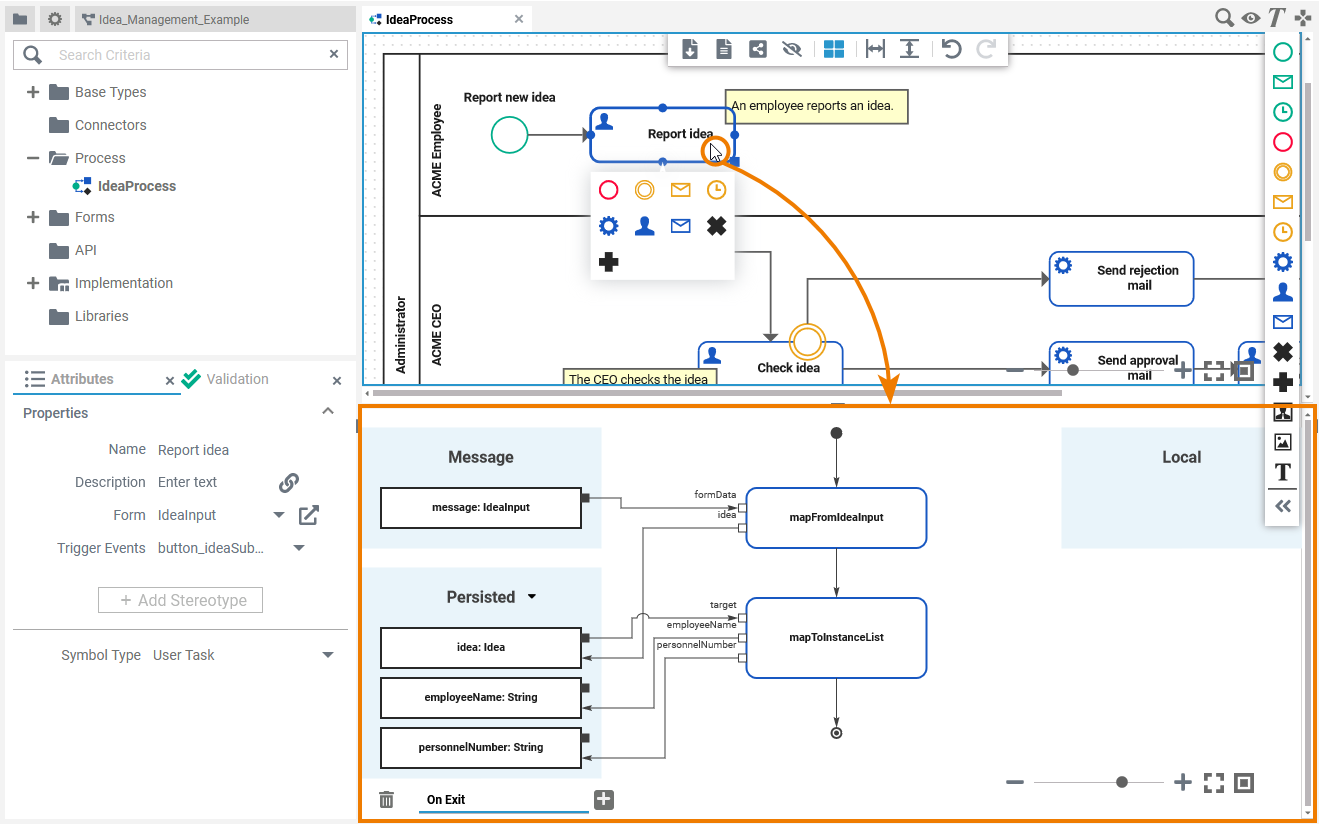Page History
Versions Compared
Key
- This line was added.
- This line was removed.
- Formatting was changed.
Once you have modeled your business process on the diagram pane, you have to add the necessary execution parts to this process to bring it to life. The execution pane is the place where you make your model executable.
| Multiexcerpt include | ||||||||
|---|---|---|---|---|---|---|---|---|
|
The Execution Pane
The execution pane is displayed below the diagram pane. It is shown as soon as you click on one of the BPMN elements:

The content of the execution pane depends on the selected BPMN element - three different views are possible:
| Selected BPMN Elements | Pane Content | Execution Pane View |
|---|---|---|
| ||
| ||
|
|
Execution Pane Contents
| Section | Description | ||||||||||
|---|---|---|---|---|---|---|---|---|---|---|---|
Operations Flow | Every execution pane contains an empty operations flow with start and end node. | ||||||||||
Persisted |
| ||||||||||
| Local |
| ||||||||||
| Message | Section Message is shown for all BPMN elements that need to process an incoming message. As per default, the incoming message has type any. To gain access to the data used in your process, you have to apply the correct type from a customized library. | ||||||||||
| Return | Only for outgoing relations of Exclusive Gateways Section Return is displayed, containing the unchangeable variable return of type boolean. |
| Adding content to the execution pane is simple: Just drag & drop the elements you want to use from the library panel to the execution pane. Two different kinds of elements can be added to the pane:
| ||
A variable is added when you use a class (
| |||
An operation call is added when you drag & drop an operation (
|
Customizing the Execution Pane
| You have several options to adjust the execution pane. When you open the pane for the first time, the default view is displayed:
|
Managing the Execution Pane
| Multiexcerpt include | ||||||
|---|---|---|---|---|---|---|
|
| |||||||||||
|
| ||||||||||
| Use the |
Modeling on the Execution Pane
| Action | Example | Description | ||||||||||
|---|---|---|---|---|---|---|---|---|---|---|---|---|
| Zoom | When modeling, you have two options to apply the zoom on the pane.
| |||||||||||
| Shifting Content | You have various options to shift the content on the pane:
| |||||||||||
| Scaling |
| |||||||||||
|
The Execution Context Menus
Two different context menus support the user on the execution pane:
Elements Context Menu
| |||||||
|---|---|---|---|---|---|---|---|
If you right click on an element, the tools context menu opens. Use it to edit the current element. The following options are available:
| |||||||
| You can use the elements context menu on all elements on the execution pane. | |||||||
Execution Pane Context Menu
| |||||||
A right click on the execution pane itself opens another context menu including the following options:
| |||||||
Shortcuts
You can also use the following shortcuts on the execution pane. The operations are applied to the currently selected element. The following list of shortcurts can be searched. Enter your search term in the Global Filter field.
| Table Filter | ||||||||||||||||||||||||
|---|---|---|---|---|---|---|---|---|---|---|---|---|---|---|---|---|---|---|---|---|---|---|---|---|
| ||||||||||||||||||||||||
|
| Otp | ||||
|---|---|---|---|---|
|
| Rp |
|---|
